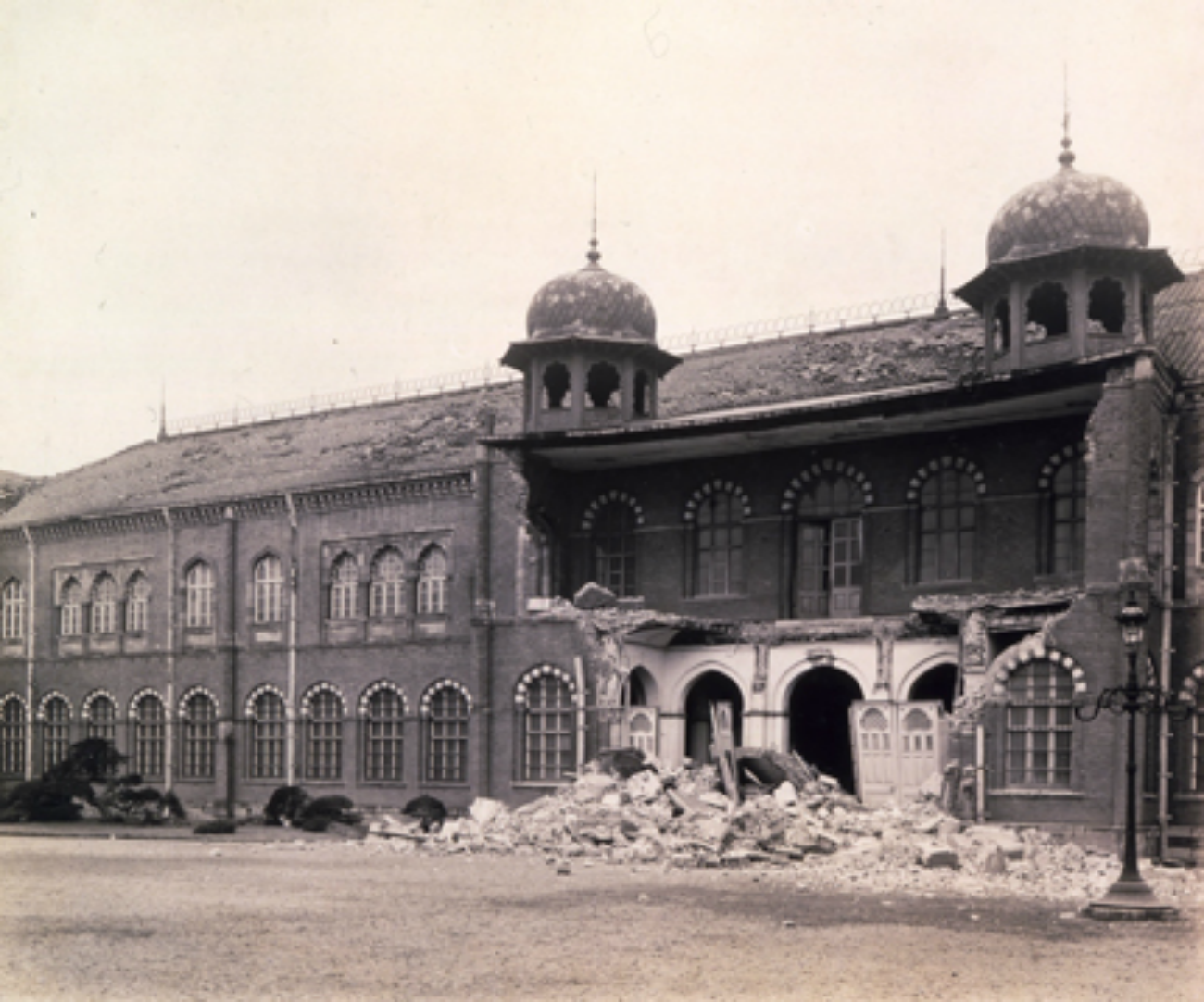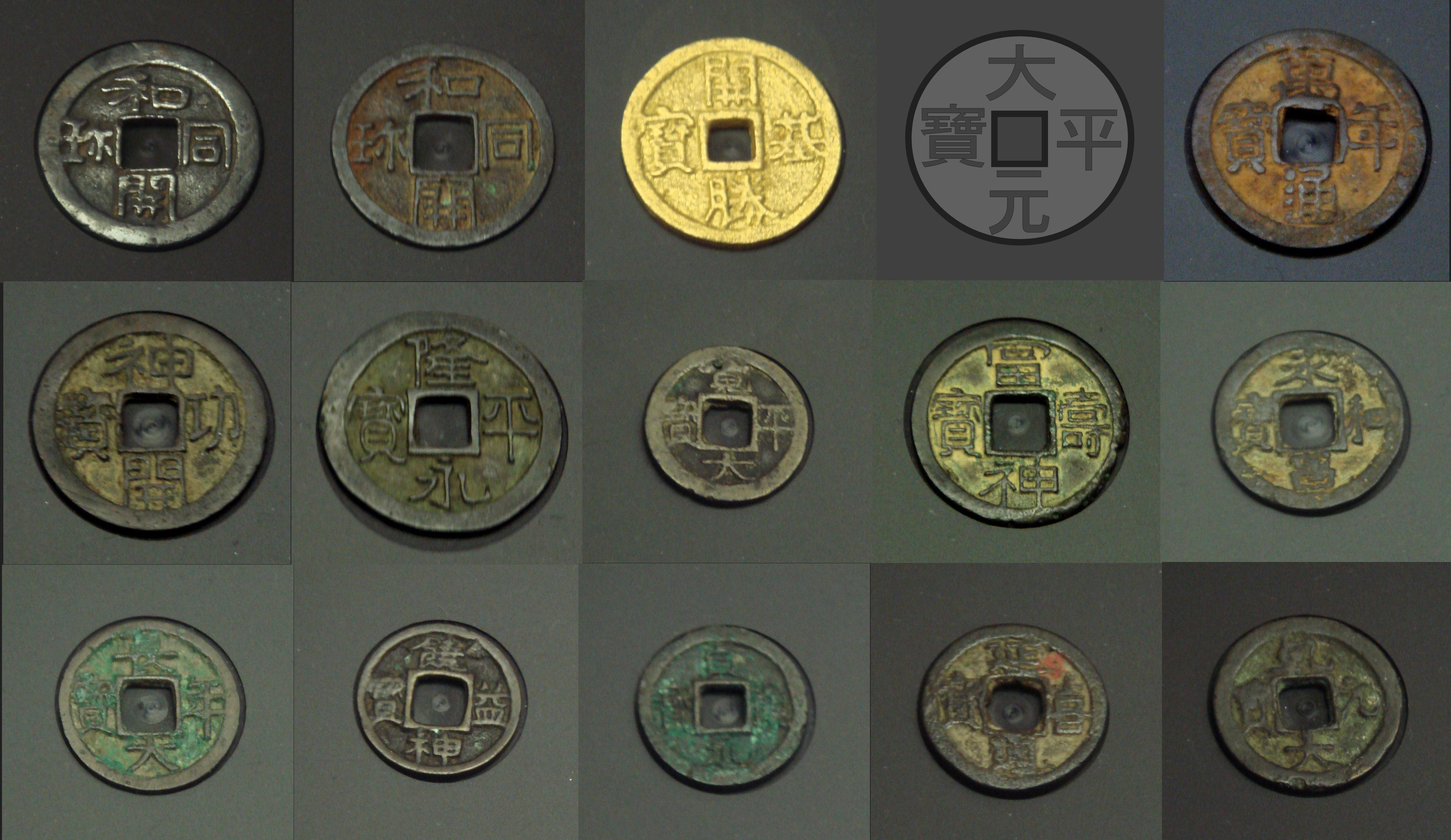|
Kaiki Shoho
is an early form of Japanese currency that was issued in 760 (Tenpyō-hōji 4) during the Nara period. These coins were struck in a gold alloy, and have a circular square hole in the middle. Very few "Kaiki Shoho" coins were minted as they were possibly an early experiment. This is not a collectible type of coinage as the only 32 surviving coins are held by the Japanese government. History "Kaiki Shoho" coins were issued in the fourth year of Tenpyō-hōji (760) during the reign of Emperor Junnin along with silver Taihei Genpō, and bronze Mannen Tsūhō coins. All three of these denominations are said to have characters written by scholar Kibi no Makibi. "Kaiki Shoho" in particular were minted on the order of Daijō-daijin Fujiwara no Nakamaro, who was leading the government at the time. They were fixed in value and had an exchange ratio of 1 gold Kaiki Shoho coin for 10 silver Taihei Genpō or 100 bronze Mannen Tsūhō coins. Based on historical sources and archaeological ... [...More Info...] [...Related Items...] OR: [Wikipedia] [Google] [Baidu] |
Japanese Currency
Japanese currency has a history covering the period from the 8th century CE to the present. After the traditional usage of rice as a commodity currency, currency medium, Japan adopted History of Chinese currency, currency systems and designs from China before developing a separate system of its own. History Commodity money Before the 7th-8th centuries CE, Japan used commodity money for trading. This generally consisted of material that was compact and easily transportable and had a widely recognized value. Commodity money was a great improvement over simple barter, in which commodities were simply exchanged against others. Ideally, commodity money had to be widely accepted, easily portable and storable, and easily combined and divided in order to correspond to different values. The main items of commodity money in Japan were arrowheads, rice grains and gold powder. This contrasted somewhat with countries like China, where one of the most important items of commodity money ... [...More Info...] [...Related Items...] OR: [Wikipedia] [Google] [Baidu] |
Kansei
was a after '' Tenmei'' and before '' Kyōwa''. This period spanned the years from January 1789 through February 1801. The reigning emperor was . Change of era * 1789 : The new era name of '' Kansei'' (meaning "Tolerant Government" or "Broad-minded Government") was created to mark a number of calamities, including a devastating fire at the Imperial Palace. The previous era ended and a new one commenced in ''Tenmei'' 9, on the 25th day of the 1st month. Events of the Kansei era The broad panoply of changes and new initiatives of the Tokugawa shogunate during this era became known as the Kansei Reforms. Matsudaira Sadanobu (1759–1829) was named the shōgun's chief councilor (''rōjū'') in the summer of 1787; and early in the next year, he became the regent for the 11th shōgun, Tokugawa Ienari. As the chief administrative decision-maker in the ''bakufu'' hierarchy, he was in a position to effect radical change; and his initial actions represented an aggressive break with t ... [...More Info...] [...Related Items...] OR: [Wikipedia] [Google] [Baidu] |
Japanese Gold Coins
Japanese may refer to: * Something from or related to Japan, an island country in East Asia * Japanese language, spoken mainly in Japan * Japanese people, the ethnic group that identifies with Japan through ancestry or culture ** Japanese diaspora, Japanese emigrants and their descendants around the world * Japanese citizens, nationals of Japan under Japanese nationality law ** Foreign-born Japanese, naturalized citizens of Japan * Japanese writing system, consisting of kanji and kana * Japanese cuisine, the food and food culture of Japan See also * List of Japanese people * * Japonica (other) * Japanese studies , sometimes known as Japanology in Europe, is a sub-field of area studies or East Asian studies involved in social sciences and humanities research on Japan. It incorporates fields such as the study of Japanese language, history, culture, litera ... {{disambiguation Language and nationality disambiguation pages ... [...More Info...] [...Related Items...] OR: [Wikipedia] [Google] [Baidu] |
Tokyo National Museum
The or TNM is an art museum in Ueno Park in the Taitō wards of Tokyo, ward of Tokyo, Japan. It is one of the four museums operated by the , is considered the oldest national museum and the largest art museum in Japan. The museum collects, preserves, and displays a comprehensive collection of artwork and cultural objects from Asia, with a focus on ancient and medieval Japanese art and Asian art along the Silk Road. There is also a large collection of Greco-Buddhist art. As of April 2023, the museum held approximately 120,000 Cultural Properties, including 89 National Treasure (Japan), National Treasures, 319 List of Hōryū-ji Treasures at Tokyo National Museum, Horyuji Treasures, and 649 Important Cultural Properties of Japan, Important Cultural Properties. As of the same date, the Japanese government had designated 902 works of art and crafts as National Treasures and 10,820 works of art and crafts as Important Cultural Properties, so the museum holds about 10% of the works of a ... [...More Info...] [...Related Items...] OR: [Wikipedia] [Google] [Baidu] |
List Of Japanese Cash Coins By Inscription
Cash coins were introduced to Japan in the century inspired by the Chinese Kaiyuan Tongbao, Kaigen Tsūhō (開元通寳) Cash (Chinese coin), cash coins from the Tang dynasty. Chinese cash coins also circulated in other countries and inspired similar currencies such as the Korean mun, Ryukyuan mon, Vietnamese văn, while they also Cash coins in Indonesia, circulated as far south as Indonesia. Because these currencies were so similar cash coins around the Far East were interchangeable and Japanese cash coins circulated in other countries while foreign cash coins also circulated in Japan. The first Japanese cash coins were the Wadōkaichin (和同開珎) which were produced from 29 August 708. In 760 Japanese currency was reformed and gold and silver cash coins were introduced, however by the end of the 10th century the value of Japanese coinage had severely fallen combined with a weak central government led the Japanese to return to barter. From the 12th century onwards the Japane ... [...More Info...] [...Related Items...] OR: [Wikipedia] [Google] [Baidu] |


